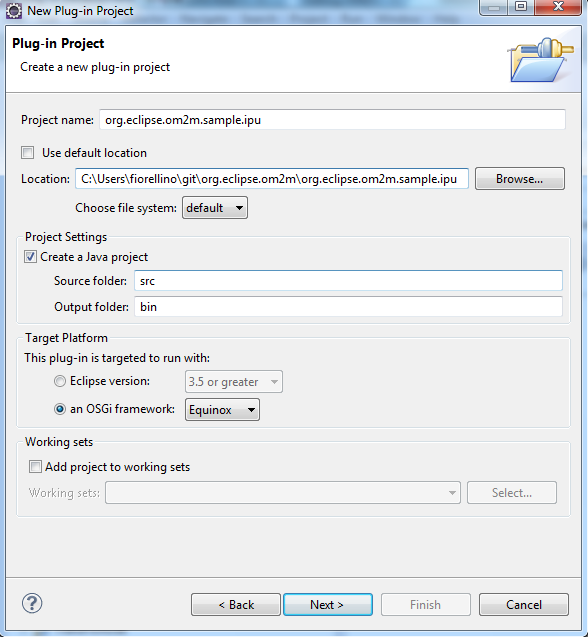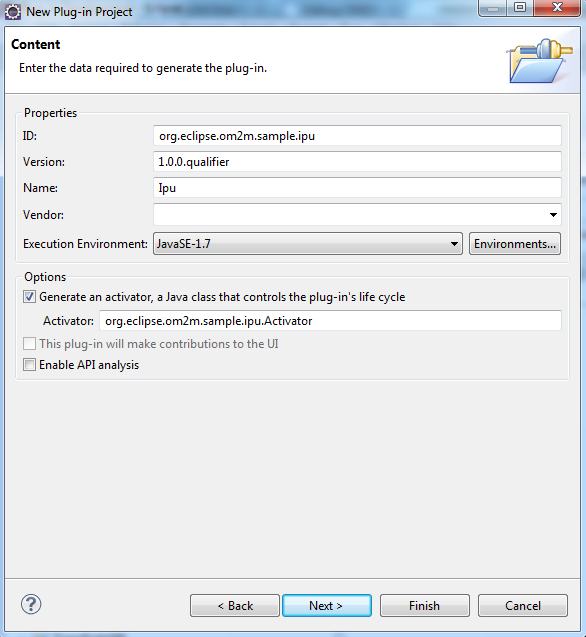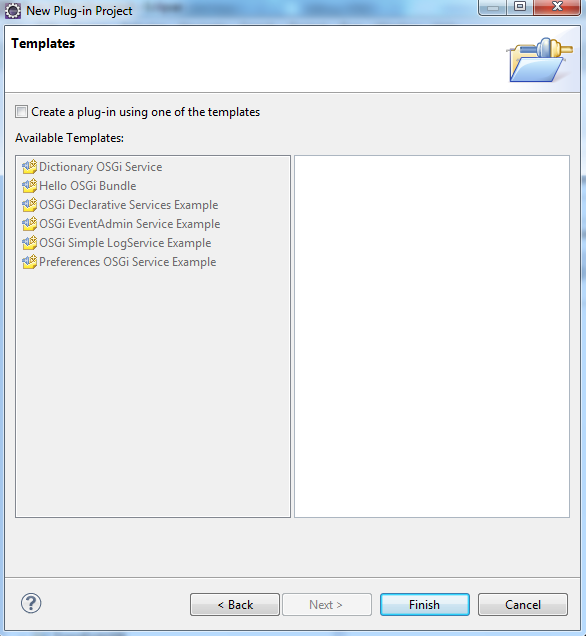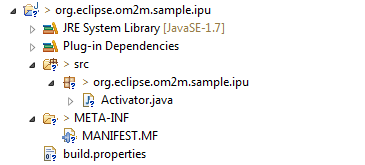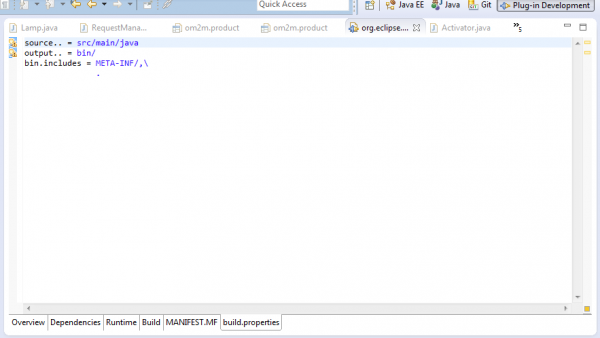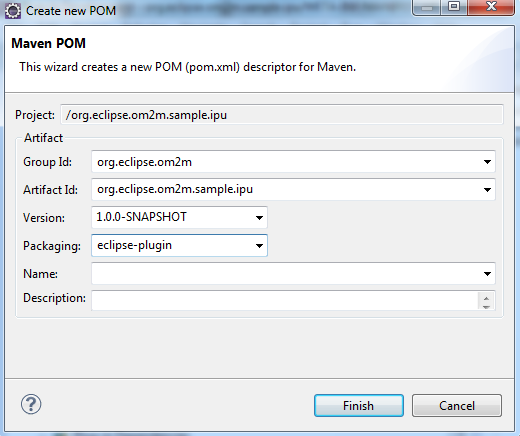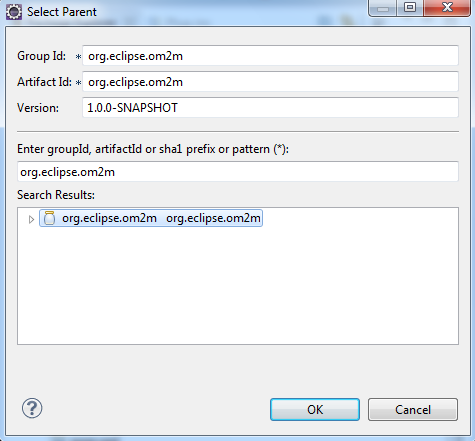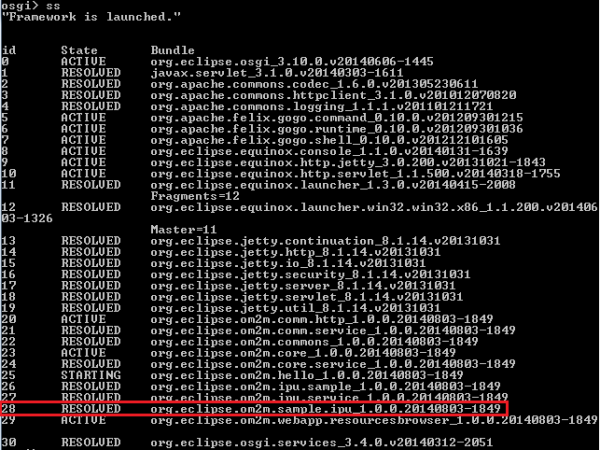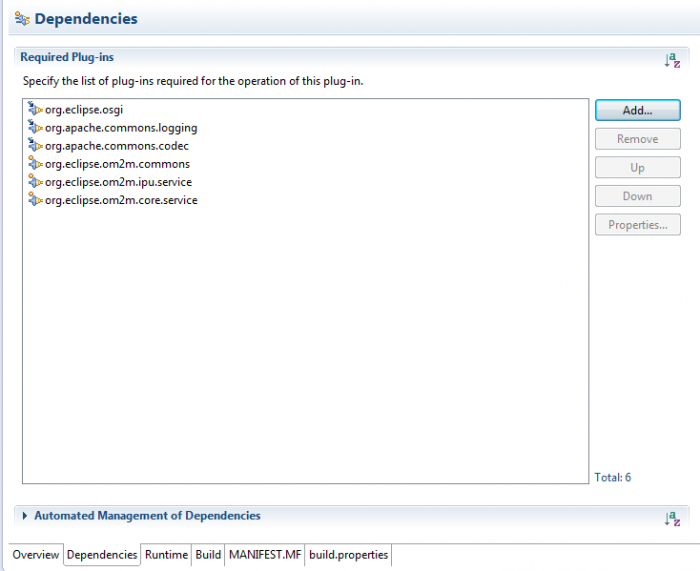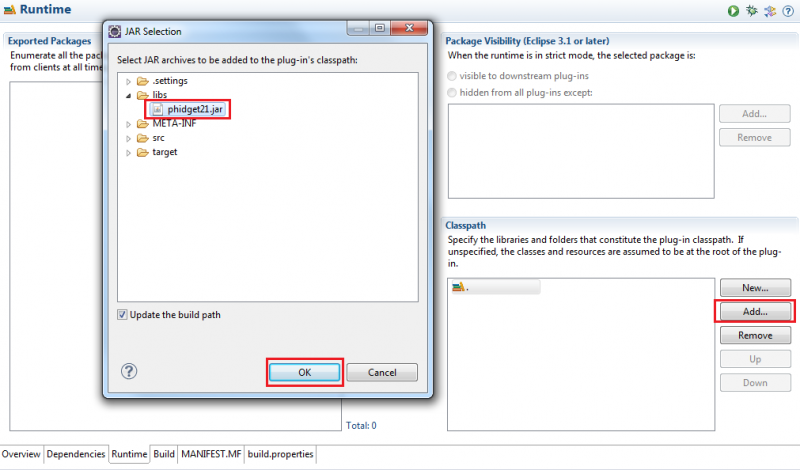Notice: this Wiki will be going read only early in 2024 and edits will no longer be possible. Please see: https://gitlab.eclipse.org/eclipsefdn/helpdesk/-/wikis/Wiki-shutdown-plan for the plan.
Difference between revisions of "OM2M/Developer"
< OM2M
(→The Sensor class) |
(Edit link at the first line, was redirecting to Download page and not to Clone and build) |
||
| (30 intermediate revisions by 2 users not shown) | |||
| Line 1: | Line 1: | ||
| + | '''Before doing this tutorial you have to''' [https://wiki.eclipse.org/OM2M/Clone clone and build OM2M using Eclipse] | ||
| + | |||
__TOC__ | __TOC__ | ||
=Add a new plug-in to OM2M= | =Add a new plug-in to OM2M= | ||
| + | |||
| + | == Clone and import OM2M == | ||
| + | * Clone OM2M using the Eclipse IDE. | ||
| + | * Import all nested projects into your workspace. | ||
== Create a new plug-in project == | == Create a new plug-in project == | ||
| Line 31: | Line 37: | ||
[[File:pom_edition.png|thumb|center|600px|maven conversion: Parent edition]] | [[File:pom_edition.png|thumb|center|600px|maven conversion: Parent edition]] | ||
| − | *We end this step by updating the plug- | + | *We end this step by updating the plug-in project. For this, select the "org.eclipse.om2m.sample.ipu" project → maven → update project. |
== Add the plugin as a maven module to the OM2M parent project == | == Add the plugin as a maven module to the OM2M parent project == | ||
| Line 66: | Line 72: | ||
=== Add plugin dependencies === | === Add plugin dependencies === | ||
* Open the manifest file of the created plugin and select Dependencies tab. | * Open the manifest file of the created plugin and select Dependencies tab. | ||
| − | * Add the dependencies depicted in the following figure. | + | * Add the dependencies depicted in the following figure. |
| + | '''Important!''' You need to import om2m nested projects into your workspace to find them in the list below. | ||
[[File:DependenciesPlugin.png|thumb|center|700px|plugin dependencies]] | [[File:DependenciesPlugin.png|thumb|center|700px|plugin dependencies]] | ||
| − | === Add jar dependencies === | + | === Add jar dependencies (Only if required) === |
If you want to add specific jar libraries to your plugin, you can follow these steps: | If you want to add specific jar libraries to your plugin, you can follow these steps: | ||
* Create a "libs" folder on your plugin project. | * Create a "libs" folder on your plugin project. | ||
| Line 79: | Line 86: | ||
= Develop an Interworking Proxy Unit (IPU) plugin = | = Develop an Interworking Proxy Unit (IPU) plugin = | ||
| − | == | + | == IPU Activator == |
| − | * In | + | * The Activator class contains the implementation of the start() and stop() method used to activate and deactivate the IPU plugin. |
| + | * In the start() method, the Activator registers the IPU Controller service on the registry to make it available for the CORE plugin. Then, it starts tracking the CORE SCL service to use it once it the CORE plugin is activated. | ||
| + | * In the Stop() method, the Activator can execute some process to make a clean before deactivation such as stopping threads, handle exceptions, etc. | ||
<source lang="java"> | <source lang="java"> | ||
package org.eclipse.om2m.sample.ipu; | package org.eclipse.om2m.sample.ipu; | ||
| − | import | + | import org.apache.commons.logging.Log; |
| − | import | + | import org.apache.commons.logging.LogFactory; |
| + | import org.eclipse.om2m.core.service.SclService; | ||
| + | import org.eclipse.om2m.ipu.service.IpuService; | ||
| + | import org.osgi.framework.BundleActivator; | ||
| + | import org.osgi.framework.BundleContext; | ||
| + | import org.osgi.framework.ServiceReference; | ||
| + | import org.osgi.util.tracker.ServiceTracker; | ||
| − | public class | + | public class Activator implements BundleActivator { |
| − | + | private static Log logger = LogFactory.getLog(Activator.class); | |
| − | + | private ServiceTracker<Object, Object> sclServiceTracker; | |
| − | + | // Activate the plugin | |
| − | + | public void start(BundleContext context) throws Exception { | |
| − | + | logger.info("IPU started"); | |
| − | + | ||
| − | + | // Register the IPU Controller service | |
| − | + | logger.info("Register IpuService.."); | |
| − | + | context.registerService(IpuService.class.getName(), new Controller(), null); | |
| − | + | logger.info("IpuService is registered."); | |
| − | public | + | |
| − | + | ||
| − | + | ||
| − | + | ||
| − | + | ||
| − | + | ||
| − | + | ||
| − | + | ||
| − | + | ||
| − | + | ||
| − | + | ||
| − | + | ||
| − | + | ||
| − | + | ||
| − | + | ||
| − | + | ||
| − | + | ||
| − | + | ||
| − | + | ||
| − | + | ||
| − | + | ||
| − | + | ||
| − | + | ||
| − | + | ||
| − | + | ||
| − | + | ||
| − | + | ||
| − | + | ||
| − | + | ||
| − | + | // Track the CORE SCL service | |
| − | + | sclServiceTracker = new ServiceTracker<Object, Object>(context, | |
| − | + | SclService.class.getName(), null) { | |
| − | + | public void removedService(ServiceReference<Object> reference, Object service) { | |
| − | + | logger.info("SclService removed"); | |
| − | + | } | |
| − | + | public Object addingService(ServiceReference<Object> reference) { | |
| − | + | logger.info("SclService discovered"); | |
| − | + | SclService sclService = (SclService) this.context.getService(reference); | |
| − | + | final Monitor IpuMonitor = new Monitor(sclService); | |
| − | + | new Thread() { | |
| − | + | public void run() { | |
| + | try { | ||
| + | IpuMonitor.start(); | ||
| + | } catch (Exception e) { | ||
| + | logger.error("IpuMonitor error", e); | ||
| + | } | ||
| + | } | ||
| + | }.start(); | ||
| + | return sclService; | ||
| + | } | ||
| + | }; | ||
| + | sclServiceTracker.open(); | ||
| + | } | ||
| + | |||
| + | // Deactivate the plugin | ||
| + | public void stop(BundleContext context) throws Exception { | ||
| + | logger.info("IPU stopped"); | ||
| + | } | ||
| + | } | ||
| − | + | </source> | |
| − | + | ||
| − | + | ||
| − | + | ||
| − | + | ||
| − | + | ||
| − | + | ||
| − | + | ||
| − | + | ||
| − | + | ||
| − | + | == IPU Monitor == | |
| − | + | ||
| − | + | ||
| − | + | ||
| − | + | ||
| − | + | ||
| − | + | * The Monitor class creates one sensor application called "MY_SENSOR", and one actuator application called "MY_ACTUATOR". It creates two containers for each application: "DESCRIPTOR" container to store the description and "DATA" container to store the measurements. For each container the right oBIX XML payload is created as contentInstance. | |
| − | + | ||
| − | + | * The Monitor starts two threads to listen to each application data as well. Once a new data is detected, the Monitor creates a new contentInstance including the measurement representation. | |
| − | + | <source lang="java"> | |
| + | package org.eclipse.om2m.sample.ipu; | ||
| − | * | + | import org.eclipse.om2m.commons.resource.*; |
| + | import org.eclipse.om2m.commons.rest.*; | ||
| + | import org.eclipse.om2m.core.service.SclService; | ||
| − | + | public class Monitor { | |
| + | static SclService core; | ||
| + | static String sclId = System.getProperty("org.eclipse.om2m.sclBaseId", ""); | ||
| + | static String reqEntity = System.getProperty("org.eclipse.om2m.adminRequestingEntity", ""); | ||
| + | static String ipuId = "sample"; | ||
| + | static String actuatorId = "MY_ACTUATOR"; | ||
| + | static String sensorId = "MY_SENSOR"; | ||
| + | static boolean actuatorValue = false; | ||
| + | static int sensorValue = 0; | ||
| + | |||
| + | public Monitor(SclService sclService) { | ||
| + | core = sclService; | ||
| + | } | ||
| − | + | public void start() { | |
| − | + | // Create required resources for the Sensor | |
| + | createSensorResources(); | ||
| + | // Listen for the Sensor data | ||
| + | listenToSensor(); | ||
| − | + | // Create required resources for the Actuator | |
| − | + | createActuatorResources(); | |
| + | // Listen for the Actuator data | ||
| + | listenToActuator(); | ||
| + | } | ||
| − | + | public void createSensorResources() { | |
| − | + | String targetId, content; | |
| + | |||
| + | // Create the MY_SENSOR application | ||
| + | targetId = sclId + "/applications"; | ||
| + | ResponseConfirm response = core | ||
| + | .doRequest(new RequestIndication("CREATE", targetId, reqEntity, | ||
| + | new Application(sensorId, ipuId))); | ||
| − | + | if (response.getStatusCode().equals(StatusCode.STATUS_CREATED)) { | |
| − | + | // Create the "DESCRIPTOR" container | |
| − | + | targetId = sclId + "/applications/" + sensorId + "/containers"; | |
| − | + | core.doRequest(new RequestIndication("CREATE", targetId, reqEntity, | |
| − | + | new Container("DESCRIPTOR"))); | |
| − | + | ||
| − | + | // Create the "DATA" container | |
| − | + | core.doRequest(new RequestIndication("CREATE", targetId, reqEntity, | |
| − | + | new Container("DATA"))); | |
| + | // Create the description contentInstance | ||
| + | content = Mapper.getSensorDescriptorRep(sclId, sensorId, ipuId); | ||
| + | targetId = sclId + "/applications/" + sensorId | ||
| + | + "/containers/DESCRIPTOR/contentInstances"; | ||
| + | core.doRequest(new RequestIndication("CREATE", targetId, reqEntity, | ||
| + | new ContentInstance(content.getBytes()))); | ||
| + | |||
| + | // Create the data contentInstance | ||
| + | content = Mapper.getSensorDataRep(sensorValue); | ||
| + | targetId = sclId + "/applications/" + sensorId | ||
| + | + "/containers/DATA/contentInstances"; | ||
| + | core.doRequest(new RequestIndication("CREATE", targetId, reqEntity, | ||
| + | new ContentInstance(content.getBytes()))); | ||
| + | } | ||
| + | } | ||
| − | public | + | public void createActuatorResources() { |
| − | + | String targetId, content; | |
| − | + | ||
| − | + | // Create the "MY_ACTUATOR" application | |
| − | + | targetId = sclId + "/applications"; | |
| − | + | ResponseConfirm response = core.doRequest(new RequestIndication( | |
| − | + | "CREATE", targetId, reqEntity, new Application(actuatorId,ipuId))); | |
| − | + | ||
| − | + | ||
| − | + | ||
| − | + | ||
| − | + | ||
| − | + | ||
| − | + | ||
| − | + | ||
| − | + | ||
| − | + | ||
| − | + | ||
| − | + | ||
| − | + | ||
| − | + | ||
| − | + | ||
| − | + | ||
| − | + | ||
| − | + | ||
| − | + | ||
| − | + | ||
| − | + | ||
| − | + | ||
| − | + | ||
| − | + | ||
| − | + | if (response.getStatusCode().equals(StatusCode.STATUS_CREATED)) { | |
| − | + | // Create the "DESCRIPTOR" container | |
| + | targetId = sclId + "/applications/" + actuatorId + "/containers"; | ||
| + | core.doRequest(new RequestIndication("CREATE", targetId, reqEntity, | ||
| + | new Container("DESCRIPTOR"))); | ||
| − | + | // Create the "DATA" container | |
| − | + | core.doRequest(new RequestIndication("CREATE", targetId, reqEntity, | |
| − | + | new Container("DATA"))); | |
| − | + | ||
| − | + | ||
| − | + | ||
| − | + | // Create the description contentInstance | |
| − | + | content = Mapper.getActutaorDescriptorRep(sclId, actuatorId, ipuId); | |
| − | + | targetId = sclId + "/applications/" + actuatorId | |
| − | + | + "/containers/DESCRIPTOR/contentInstances"; | |
| − | + | core.doRequest(new RequestIndication("CREATE", targetId, reqEntity, | |
| − | + | content)); | |
| − | + | ||
| − | + | ||
| − | + | ||
| − | + | ||
| − | + | ||
| − | + | ||
| − | + | ||
| − | + | ||
| − | + | ||
| − | + | ||
| − | + | ||
| − | + | ||
| − | + | ||
| − | + | ||
| − | + | // Create the data contentInstance | |
| − | + | content = Mapper.getActuatorDataRep(actuatorValue); | |
| − | + | targetId = sclId + "/applications/" + actuatorId | |
| − | + | + "/containers/DATA/contentInstances"; | |
| − | + | core.doRequest(new RequestIndication("CREATE", targetId, reqEntity, | |
| − | + | content)); | |
| − | + | } | |
| − | + | } | |
| − | + | ||
| − | + | ||
| − | + | ||
| − | + | ||
| − | + | ||
| − | + | ||
| − | + | ||
| − | + | ||
| − | + | public void listenToSensor() { | |
| − | + | new Thread() { | |
| − | + | public void run() { | |
| − | + | while (true) { | |
| − | + | // Simualte a random measurement of the sensor | |
| − | + | sensorValue = 10 + (int) (Math.random() * 100); | |
| − | + | ||
| − | + | ||
| − | + | ||
| − | + | ||
| − | + | ||
| − | + | ||
| − | + | ||
| − | + | ||
| − | + | ||
| − | + | ||
| − | + | ||
| − | + | ||
| − | + | ||
| − | + | ||
| − | + | ||
| − | + | ||
| − | + | ||
| − | + | ||
| − | + | ||
| − | + | ||
| − | + | // Create a data contentInstance | |
| − | + | String content = Mapper.getSensorDataRep(sensorValue); | |
| − | + | String targetID = sclId + "/applications/" + sensorId | |
| − | + | + "/containers/DATA/contentInstances"; | |
| − | + | core.doRequest(new RequestIndication("CREATE", targetID,reqEntity, | |
| − | + | content)); | |
| − | + | ||
| − | + | // Wait for 2 seconds then loop | |
| − | + | try { | |
| − | + | Thread.sleep(2000); | |
| − | + | } catch (InterruptedException e) { | |
| − | + | e.printStackTrace(); | |
| − | + | } | |
| − | + | } | |
| − | + | } | |
| − | + | }.start(); | |
| − | + | } | |
| − | + | ||
| − | + | ||
| − | + | ||
| − | + | ||
| − | + | ||
| − | + | ||
| − | + | ||
| − | + | ||
| − | + | ||
| − | + | ||
| − | + | ||
| − | + | ||
| − | + | ||
| − | + | ||
| − | + | ||
| − | + | ||
| − | + | ||
| − | + | ||
| − | + | ||
| − | + | ||
| − | + | ||
| − | + | ||
| − | + | ||
| − | + | ||
| − | + | ||
| − | + | ||
| + | public void listenToActuator() { | ||
| + | new Thread() { | ||
| + | public void run() { | ||
| + | |||
| + | boolean memorizedActuatorValue = false; | ||
| + | while (true) { | ||
| + | // If the Actuator state has changed | ||
| + | if (memorizedActuatorValue != actuatorValue) { | ||
| + | // Memorize the new Actuator state | ||
| + | memorizedActuatorValue = actuatorValue; | ||
| + | |||
| + | // Create a data contentInstance | ||
| + | String content = Mapper.getActuatorDataRep(actuatorValue); | ||
| + | String targetID = sclId + "/applications/" + actuatorId | ||
| + | + "/containers/DATA/contentInstances"; | ||
| + | core.doRequest(new RequestIndication("CREATE",targetID, reqEntity, | ||
| + | content)); | ||
| + | } | ||
| + | |||
| + | // Wait for 2 seconds then loop | ||
| + | try { | ||
| + | Thread.sleep(2000); | ||
| + | } catch (InterruptedException e) { | ||
| + | e.printStackTrace(); | ||
| + | } | ||
| + | } | ||
| + | } | ||
| + | }.start(); | ||
| + | } | ||
} | } | ||
</source> | </source> | ||
| − | |||
| − | == | + | == IPU Mapper == |
| − | * | + | * Convert the description and the measured data of the device to oBIX XML representation. |
| − | + | ||
| − | + | ||
| − | + | ||
| − | + | ||
| − | + | ||
<source lang="java"> | <source lang="java"> | ||
package org.eclipse.om2m.sample.ipu; | package org.eclipse.om2m.sample.ipu; | ||
| + | import org.eclipse.om2m.commons.obix.*; | ||
| + | import org.eclipse.om2m.commons.obix.io.ObixEncoder; | ||
| − | + | public class Mapper { | |
| − | + | ||
| − | + | ||
| − | + | ||
| − | + | ||
| − | + | ||
| − | + | ||
| + | public static String getSensorDescriptorRep(String sclId, String appId, String ipuId) { | ||
| + | Obj obj = new Obj(); | ||
| + | Op opGet = new Op(); | ||
| + | opGet.setName("GET"); | ||
| + | opGet.setHref(new Uri(sclId + "/applications/" + appId | ||
| + | + "/containers/DATA/contentInstances/latest/content")); | ||
| + | opGet.setIs(new Contract("retrieve")); | ||
| + | obj.add(opGet); | ||
| − | + | Op opGetDirect = new Op(); | |
| − | + | opGetDirect.setName("GET(Direct)"); | |
| − | + | opGetDirect.setHref(new Uri(sclId + "/applications/" + appId + "/" + ipuId)); | |
| − | + | opGetDirect.setIs(new Contract("retrieve")); | |
| − | + | obj.add(opGetDirect); | |
| − | + | return ObixEncoder.toString(obj); | |
| − | + | ||
| − | + | ||
| − | + | ||
| − | + | ||
| − | + | ||
| − | + | ||
| − | + | ||
| − | + | ||
| − | + | ||
| − | + | ||
| − | + | ||
| − | + | ||
| − | + | ||
| − | + | ||
| − | + | ||
| − | + | ||
| − | + | ||
| − | + | ||
| − | + | ||
| − | + | ||
| − | + | ||
| − | + | ||
} | } | ||
| + | public static String getActutaorDescriptorRep(String sclId, String appId, String ipuId) { | ||
| + | Obj obj = new Obj(); | ||
| − | + | Op opGet = new Op(); | |
| − | + | opGet.setName("GET"); | |
| − | + | opGet.setHref(new Uri(sclId + "/applications/" + appId | |
| − | + | + "/containers/DATA/contentInstances/latest/content")); | |
| − | + | opGet.setIs(new Contract("retrieve")); | |
| − | + | obj.add(opGet); | |
| − | + | ||
| − | + | ||
| − | + | ||
| − | + | ||
| − | + | ||
| − | + | ||
| − | + | ||
| − | + | ||
| − | + | ||
| − | + | ||
| − | + | ||
| − | + | ||
| − | + | ||
| − | + | ||
| − | + | ||
| − | + | ||
| − | + | ||
| − | + | ||
| − | + | ||
| + | Op opGetDirect = new Op(); | ||
| + | opGetDirect.setName("GET(Direct)"); | ||
| + | opGetDirect.setHref(new Uri(sclId + "/applications/" + appId + "/" + ipuId)); | ||
| + | opGetDirect.setIs(new Contract("retrieve")); | ||
| + | obj.add(opGetDirect); | ||
| − | + | Op opON = new Op(); | |
| − | + | opON.setName("ON"); | |
| − | + | opON.setHref(new Uri(sclId + "/applications/" + appId + "/" + ipuId + "/true")); | |
| − | + | opON.setIs(new Contract("execute")); | |
| + | obj.add(opON); | ||
| − | + | Op opOFF = new Op(); | |
| − | + | opOFF.setName("OFF"); | |
| − | + | opOFF.setHref(new Uri(sclId + "/applications/" + appId + "/" + ipuId + "/false")); | |
| − | + | opOFF.setIs(new Contract("execute")); | |
| + | obj.add(opOFF); | ||
| + | |||
| + | return ObixEncoder.toString(obj); | ||
} | } | ||
| − | + | public static String getActuatorDataRep(boolean value) { | |
| − | public | + | Obj obj = new Obj(); |
| − | + | obj.add(new Bool("data", value)); | |
| − | + | return ObixEncoder.toString(obj); | |
} | } | ||
| − | + | public static String getSensorDataRep(int value) { | |
| − | public String | + | Obj obj = new Obj(); |
| − | + | obj.add(new Int("data", value)); | |
| − | return | + | return ObixEncoder.toString(obj); |
} | } | ||
| − | |||
} | } | ||
</source> | </source> | ||
| − | == | + | == IPU Controller == |
| − | + | ||
| − | + | * Execute received requests from OM2M to the specific technologies. | |
| + | |||
<source lang="java"> | <source lang="java"> | ||
package org.eclipse.om2m.sample.ipu; | package org.eclipse.om2m.sample.ipu; | ||
| − | import org. | + | import org.eclipse.om2m.commons.resource.StatusCode; |
| − | + | import org.eclipse.om2m.commons.rest.*; | |
| − | import org.eclipse.om2m. | + | |
import org.eclipse.om2m.ipu.service.IpuService; | import org.eclipse.om2m.ipu.service.IpuService; | ||
| − | |||
| − | |||
| − | |||
| − | |||
| + | public class Controller implements IpuService { | ||
| + | public ResponseConfirm doExecute(RequestIndication requestIndication) { | ||
| + | String[] parts = requestIndication.getTargetID().split("/"); | ||
| + | String appId = parts[2]; | ||
| + | String value = parts[4]; | ||
| − | + | if (appId.equals(Monitor.actuatorId)) { | |
| + | Monitor.actuatorValue = Boolean.parseBoolean(value); | ||
| + | return new ResponseConfirm(StatusCode.STATUS_OK); | ||
| + | } else { | ||
| + | return new ResponseConfirm(StatusCode.STATUS_NOT_FOUND, appId + " not found"); | ||
| + | } | ||
| + | } | ||
| − | + | public ResponseConfirm doRetrieve(RequestIndication requestIndication) { | |
| − | + | String[] parts = requestIndication.getTargetID().split("/"); | |
| − | + | String appId = parts[2]; | |
| − | + | String content; | |
| − | + | ||
| − | + | ||
| − | + | ||
| − | + | ||
| − | + | ||
| − | + | ||
| − | + | ||
| − | + | if (appId.equals(Monitor.sensorId)) { | |
| − | + | content = Mapper.getSensorDataRep(Monitor.sensorValue); | |
| − | + | return new ResponseConfirm(StatusCode.STATUS_OK, content); | |
| + | } else if (appId.equals(Monitor.actuatorId)) { | ||
| + | content = Mapper.getActuatorDataRep(Monitor.actuatorValue); | ||
| + | return new ResponseConfirm(StatusCode.STATUS_OK, content); | ||
| + | } else { | ||
| + | return new ResponseConfirm(StatusCode.STATUS_NOT_FOUND, appId + " not found"); | ||
| + | } | ||
| − | + | } | |
| − | + | ||
| − | + | ||
| − | + | ||
| − | + | public ResponseConfirm doUpdate(RequestIndication requestIndication) { | |
| − | + | return new ResponseConfirm(StatusCode.STATUS_NOT_IMPLEMENTED, | |
| − | + | requestIndication.getMethod() + " not Implemented"); | |
| − | + | ||
| − | + | ||
| − | + | ||
| − | + | ||
| − | + | ||
| − | + | ||
| − | + | ||
| − | + | ||
| − | + | ||
| − | + | ||
| − | + | ||
| − | + | ||
| − | + | ||
| − | + | ||
| − | + | ||
| − | + | ||
| − | + | ||
| − | + | ||
| − | + | ||
| − | + | ||
| − | + | ||
} | } | ||
| + | public ResponseConfirm doDelete(RequestIndication requestIndication) { | ||
| + | return new ResponseConfirm(StatusCode.STATUS_NOT_IMPLEMENTED, | ||
| + | requestIndication.getMethod() + " not Implemented"); | ||
| + | } | ||
| + | public ResponseConfirm doCreate(RequestIndication requestIndication) { | ||
| + | return new ResponseConfirm(StatusCode.STATUS_NOT_IMPLEMENTED, | ||
| + | requestIndication.getMethod() + " not Implemented"); | ||
| + | } | ||
| + | |||
| + | public String getAPOCPath(){ | ||
| + | return Monitor.ipuId; | ||
| + | } | ||
} | } | ||
</source> | </source> | ||
| − | |||
| − | |||
| − | |||
| − | |||
| − | |||
| − | |||
| − | |||
| − | |||
| − | |||
| − | |||
| − | |||
| − | |||
| − | |||
| − | |||
| − | |||
| − | |||
| − | |||
| − | |||
| − | |||
| − | |||
| − | |||
| − | |||
| − | |||
| − | |||
| − | |||
Latest revision as of 06:10, 12 November 2015
Before doing this tutorial you have to clone and build OM2M using Eclipse
Contents
- 1 Add a new plug-in to OM2M
- 2 Develop an Interworking Proxy Unit (IPU) plugin
Add a new plug-in to OM2M
Clone and import OM2M
- Clone OM2M using the Eclipse IDE.
- Import all nested projects into your workspace.
Create a new plug-in project
- Create a new plug-in project called org.eclipse.om2m.sample.ipu via File → New → Other → Plug-in Project.
- Enter the data as depicted in the following screenshots.
- Uncheck the Create a plug-in using one of the templates checkbook and press the Finish button.
- As result the following project is created.
Convert the plugin into maven project
- Open the build.properties file in XML and update the src attributes as depicted in the following figure.
- Select the created plug-in "org.eclipse.om2m.sample.ipu" → right click → configure → convert to maven project.
- Enter the data as illustrated in the following and press the Finish button.
- Once the plug-in is converted, open the pom.xml file to edit the parent filed.
- Click on "select Parent" icon and enter "org.eclipse.om2m" in the "Enter groupId, artifactId or sh1 prefix or pattern" field.
- Select "org.om2m.eclipse" and press ok.
- We end this step by updating the plug-in project. For this, select the "org.eclipse.om2m.sample.ipu" project → maven → update project.
Add the plugin as a maven module to the OM2M parent project
- In this part, we will add the created plug-in as a module to the om2m platform:
- Open the pom file of the org.eclipse.om2m package.
- Go to the modules tab and press Add button.
- Select the org.eclipse.ipu.om2m.sample.ipu plug-in and press ok.
- Build the om2m package and its sub-projects. To do this, select the "om2m.org.eclipse" package → right click → Run as → maven install.
- Check the org.eclipse.om2m.sample.ipu was successfully built. At the buid end, we should get this result.
- Remark: To keep the same display pattern for all the platform' plugins, you can add description and name tags to the org.eclipse.om2m.sample.ipu' pom.xml file.
<project> ...... <name>org.eclipse.om2m :: sample ipu</name> <description>org.eclipse.om2m :: sample ipu</description> ..... </project>
Add the plugin to the OM2M product(s)
- The final step consists of adding the created plug-in to one of om2m platform products, i.e the gscl or the nscl executable. In the following, we choose to add the org.eclipse.om2m.sample.ipu plug-in to the gscl product:
- select the org.eclipse.om2m.site.gscl package.
- open the om2m.product file.
- Press Add button and Type org.eclipse.om2m.sample.ipu
- Click on ok button and save.
- Build the om2m package and its sub-projects: select the "om2m.org.eclipse" package -> right click -> Run as -> maven install.
- To check that the "org.eclipse.om2m.sample.ipu" was successfully added to the gscl product, run the gscl and verify in the console if the "org.eclipse.om2m.sample.ipu" is displayed.
Add required dependencies
Add plugin dependencies
- Open the manifest file of the created plugin and select Dependencies tab.
- Add the dependencies depicted in the following figure.
Important! You need to import om2m nested projects into your workspace to find them in the list below.
Add jar dependencies (Only if required)
If you want to add specific jar libraries to your plugin, you can follow these steps:
- Create a "libs" folder on your plugin project.
- Put required specific jar on the "libs" folder.
- Open the manifest file of the created plugin and select "runtime" tab.
- Go to the "classpath" tab and click on the "Add" button.
- Select the required jar and click on "ok" button.
Develop an Interworking Proxy Unit (IPU) plugin
IPU Activator
- The Activator class contains the implementation of the start() and stop() method used to activate and deactivate the IPU plugin.
- In the start() method, the Activator registers the IPU Controller service on the registry to make it available for the CORE plugin. Then, it starts tracking the CORE SCL service to use it once it the CORE plugin is activated.
- In the Stop() method, the Activator can execute some process to make a clean before deactivation such as stopping threads, handle exceptions, etc.
package org.eclipse.om2m.sample.ipu; import org.apache.commons.logging.Log; import org.apache.commons.logging.LogFactory; import org.eclipse.om2m.core.service.SclService; import org.eclipse.om2m.ipu.service.IpuService; import org.osgi.framework.BundleActivator; import org.osgi.framework.BundleContext; import org.osgi.framework.ServiceReference; import org.osgi.util.tracker.ServiceTracker; public class Activator implements BundleActivator { private static Log logger = LogFactory.getLog(Activator.class); private ServiceTracker<Object, Object> sclServiceTracker; // Activate the plugin public void start(BundleContext context) throws Exception { logger.info("IPU started"); // Register the IPU Controller service logger.info("Register IpuService.."); context.registerService(IpuService.class.getName(), new Controller(), null); logger.info("IpuService is registered."); // Track the CORE SCL service sclServiceTracker = new ServiceTracker<Object, Object>(context, SclService.class.getName(), null) { public void removedService(ServiceReference<Object> reference, Object service) { logger.info("SclService removed"); } public Object addingService(ServiceReference<Object> reference) { logger.info("SclService discovered"); SclService sclService = (SclService) this.context.getService(reference); final Monitor IpuMonitor = new Monitor(sclService); new Thread() { public void run() { try { IpuMonitor.start(); } catch (Exception e) { logger.error("IpuMonitor error", e); } } }.start(); return sclService; } }; sclServiceTracker.open(); } // Deactivate the plugin public void stop(BundleContext context) throws Exception { logger.info("IPU stopped"); } }
IPU Monitor
- The Monitor class creates one sensor application called "MY_SENSOR", and one actuator application called "MY_ACTUATOR". It creates two containers for each application: "DESCRIPTOR" container to store the description and "DATA" container to store the measurements. For each container the right oBIX XML payload is created as contentInstance.
- The Monitor starts two threads to listen to each application data as well. Once a new data is detected, the Monitor creates a new contentInstance including the measurement representation.
package org.eclipse.om2m.sample.ipu; import org.eclipse.om2m.commons.resource.*; import org.eclipse.om2m.commons.rest.*; import org.eclipse.om2m.core.service.SclService; public class Monitor { static SclService core; static String sclId = System.getProperty("org.eclipse.om2m.sclBaseId", ""); static String reqEntity = System.getProperty("org.eclipse.om2m.adminRequestingEntity", ""); static String ipuId = "sample"; static String actuatorId = "MY_ACTUATOR"; static String sensorId = "MY_SENSOR"; static boolean actuatorValue = false; static int sensorValue = 0; public Monitor(SclService sclService) { core = sclService; } public void start() { // Create required resources for the Sensor createSensorResources(); // Listen for the Sensor data listenToSensor(); // Create required resources for the Actuator createActuatorResources(); // Listen for the Actuator data listenToActuator(); } public void createSensorResources() { String targetId, content; // Create the MY_SENSOR application targetId = sclId + "/applications"; ResponseConfirm response = core .doRequest(new RequestIndication("CREATE", targetId, reqEntity, new Application(sensorId, ipuId))); if (response.getStatusCode().equals(StatusCode.STATUS_CREATED)) { // Create the "DESCRIPTOR" container targetId = sclId + "/applications/" + sensorId + "/containers"; core.doRequest(new RequestIndication("CREATE", targetId, reqEntity, new Container("DESCRIPTOR"))); // Create the "DATA" container core.doRequest(new RequestIndication("CREATE", targetId, reqEntity, new Container("DATA"))); // Create the description contentInstance content = Mapper.getSensorDescriptorRep(sclId, sensorId, ipuId); targetId = sclId + "/applications/" + sensorId + "/containers/DESCRIPTOR/contentInstances"; core.doRequest(new RequestIndication("CREATE", targetId, reqEntity, new ContentInstance(content.getBytes()))); // Create the data contentInstance content = Mapper.getSensorDataRep(sensorValue); targetId = sclId + "/applications/" + sensorId + "/containers/DATA/contentInstances"; core.doRequest(new RequestIndication("CREATE", targetId, reqEntity, new ContentInstance(content.getBytes()))); } } public void createActuatorResources() { String targetId, content; // Create the "MY_ACTUATOR" application targetId = sclId + "/applications"; ResponseConfirm response = core.doRequest(new RequestIndication( "CREATE", targetId, reqEntity, new Application(actuatorId,ipuId))); if (response.getStatusCode().equals(StatusCode.STATUS_CREATED)) { // Create the "DESCRIPTOR" container targetId = sclId + "/applications/" + actuatorId + "/containers"; core.doRequest(new RequestIndication("CREATE", targetId, reqEntity, new Container("DESCRIPTOR"))); // Create the "DATA" container core.doRequest(new RequestIndication("CREATE", targetId, reqEntity, new Container("DATA"))); // Create the description contentInstance content = Mapper.getActutaorDescriptorRep(sclId, actuatorId, ipuId); targetId = sclId + "/applications/" + actuatorId + "/containers/DESCRIPTOR/contentInstances"; core.doRequest(new RequestIndication("CREATE", targetId, reqEntity, content)); // Create the data contentInstance content = Mapper.getActuatorDataRep(actuatorValue); targetId = sclId + "/applications/" + actuatorId + "/containers/DATA/contentInstances"; core.doRequest(new RequestIndication("CREATE", targetId, reqEntity, content)); } } public void listenToSensor() { new Thread() { public void run() { while (true) { // Simualte a random measurement of the sensor sensorValue = 10 + (int) (Math.random() * 100); // Create a data contentInstance String content = Mapper.getSensorDataRep(sensorValue); String targetID = sclId + "/applications/" + sensorId + "/containers/DATA/contentInstances"; core.doRequest(new RequestIndication("CREATE", targetID,reqEntity, content)); // Wait for 2 seconds then loop try { Thread.sleep(2000); } catch (InterruptedException e) { e.printStackTrace(); } } } }.start(); } public void listenToActuator() { new Thread() { public void run() { boolean memorizedActuatorValue = false; while (true) { // If the Actuator state has changed if (memorizedActuatorValue != actuatorValue) { // Memorize the new Actuator state memorizedActuatorValue = actuatorValue; // Create a data contentInstance String content = Mapper.getActuatorDataRep(actuatorValue); String targetID = sclId + "/applications/" + actuatorId + "/containers/DATA/contentInstances"; core.doRequest(new RequestIndication("CREATE",targetID, reqEntity, content)); } // Wait for 2 seconds then loop try { Thread.sleep(2000); } catch (InterruptedException e) { e.printStackTrace(); } } } }.start(); } }
IPU Mapper
- Convert the description and the measured data of the device to oBIX XML representation.
package org.eclipse.om2m.sample.ipu; import org.eclipse.om2m.commons.obix.*; import org.eclipse.om2m.commons.obix.io.ObixEncoder; public class Mapper { public static String getSensorDescriptorRep(String sclId, String appId, String ipuId) { Obj obj = new Obj(); Op opGet = new Op(); opGet.setName("GET"); opGet.setHref(new Uri(sclId + "/applications/" + appId + "/containers/DATA/contentInstances/latest/content")); opGet.setIs(new Contract("retrieve")); obj.add(opGet); Op opGetDirect = new Op(); opGetDirect.setName("GET(Direct)"); opGetDirect.setHref(new Uri(sclId + "/applications/" + appId + "/" + ipuId)); opGetDirect.setIs(new Contract("retrieve")); obj.add(opGetDirect); return ObixEncoder.toString(obj); } public static String getActutaorDescriptorRep(String sclId, String appId, String ipuId) { Obj obj = new Obj(); Op opGet = new Op(); opGet.setName("GET"); opGet.setHref(new Uri(sclId + "/applications/" + appId + "/containers/DATA/contentInstances/latest/content")); opGet.setIs(new Contract("retrieve")); obj.add(opGet); Op opGetDirect = new Op(); opGetDirect.setName("GET(Direct)"); opGetDirect.setHref(new Uri(sclId + "/applications/" + appId + "/" + ipuId)); opGetDirect.setIs(new Contract("retrieve")); obj.add(opGetDirect); Op opON = new Op(); opON.setName("ON"); opON.setHref(new Uri(sclId + "/applications/" + appId + "/" + ipuId + "/true")); opON.setIs(new Contract("execute")); obj.add(opON); Op opOFF = new Op(); opOFF.setName("OFF"); opOFF.setHref(new Uri(sclId + "/applications/" + appId + "/" + ipuId + "/false")); opOFF.setIs(new Contract("execute")); obj.add(opOFF); return ObixEncoder.toString(obj); } public static String getActuatorDataRep(boolean value) { Obj obj = new Obj(); obj.add(new Bool("data", value)); return ObixEncoder.toString(obj); } public static String getSensorDataRep(int value) { Obj obj = new Obj(); obj.add(new Int("data", value)); return ObixEncoder.toString(obj); } }
IPU Controller
- Execute received requests from OM2M to the specific technologies.
package org.eclipse.om2m.sample.ipu; import org.eclipse.om2m.commons.resource.StatusCode; import org.eclipse.om2m.commons.rest.*; import org.eclipse.om2m.ipu.service.IpuService; public class Controller implements IpuService { public ResponseConfirm doExecute(RequestIndication requestIndication) { String[] parts = requestIndication.getTargetID().split("/"); String appId = parts[2]; String value = parts[4]; if (appId.equals(Monitor.actuatorId)) { Monitor.actuatorValue = Boolean.parseBoolean(value); return new ResponseConfirm(StatusCode.STATUS_OK); } else { return new ResponseConfirm(StatusCode.STATUS_NOT_FOUND, appId + " not found"); } } public ResponseConfirm doRetrieve(RequestIndication requestIndication) { String[] parts = requestIndication.getTargetID().split("/"); String appId = parts[2]; String content; if (appId.equals(Monitor.sensorId)) { content = Mapper.getSensorDataRep(Monitor.sensorValue); return new ResponseConfirm(StatusCode.STATUS_OK, content); } else if (appId.equals(Monitor.actuatorId)) { content = Mapper.getActuatorDataRep(Monitor.actuatorValue); return new ResponseConfirm(StatusCode.STATUS_OK, content); } else { return new ResponseConfirm(StatusCode.STATUS_NOT_FOUND, appId + " not found"); } } public ResponseConfirm doUpdate(RequestIndication requestIndication) { return new ResponseConfirm(StatusCode.STATUS_NOT_IMPLEMENTED, requestIndication.getMethod() + " not Implemented"); } public ResponseConfirm doDelete(RequestIndication requestIndication) { return new ResponseConfirm(StatusCode.STATUS_NOT_IMPLEMENTED, requestIndication.getMethod() + " not Implemented"); } public ResponseConfirm doCreate(RequestIndication requestIndication) { return new ResponseConfirm(StatusCode.STATUS_NOT_IMPLEMENTED, requestIndication.getMethod() + " not Implemented"); } public String getAPOCPath(){ return Monitor.ipuId; } }

